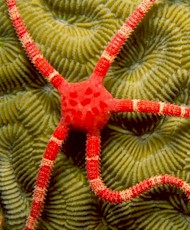Echinodermata
If you could time travel back to 400 million-year-ago seas, you would see representatives of nearly every phylum you have studied this semester. In addition, you would see many representatives of the echinoderm phylum. The majority of ancient echinoderms permanently attached to their substrate and probably were suspension feeders—a lifestyle shared by only one modern class of echinoderms. The approximately 13,000 extinct species include many distinct and often bizarre forms.
The approximately 7,000 living species of sea stars, brittle stars, sea urchins, sand dollars, sea cucumbers and sea lilies are all marine and mostly bottom dwellers. Echinoderms have attracted much attention because of their experimentally manipulative embryos, their ecological importance from the intertial zone to the deep seas, and their extensive fossil record.
 |
Phylum
Echinodermata
1.
Calcareous endoskeleton in the form
of ossicles that arise from mesodermal tissue
2.
Adults with pentaradial symmetry and
larvae with bilateral symmetry
3.
Water-vascular system comprised of
water-filled canals used in locomotion, attachment, and/or feeding
4.
Complete digestive tract that may
be secondarily reduced
5.
Hemal system derived from coelomic
cavities
6.
Nervous system consisting of a nerve
net, nerve ring, and radial nerves
|
The morphological features that unite all echinoderms are the water vascular system and a mesodermal endoskeleton comprised of numerous dermal plates called ossicles. The water-vascular system.is a hydraulic system composed of a series of water-filled canals; it originates embryologically as a modification of the coelom. Tube feet are extensions of the canal system for locomotion and for capturing prey and usually emerge through openings in skeletal ossicles. Echinoderms fossilize well because their endoskeleton is composed of calcareous ossicles. The ossicles may articulate with one another, as in the flexible sea stars and brittle stars, or may be fused together to form a rigid skeletal test, as in sea urchins and sand dollars.
Although echinoderm adults are radially symmetrical, echinoderms evolved from bilaterally symmetrical ancestors; evidence for this relationship includes bilaterally symmetrical echinoderm larval stages and extinct forms that were not radially symmetrical. In addition, all other deuterstomes are bilaterally symmetrical.
The form of radial symmetry in echinoderms where body parts are organized around an oral-aboral axis in sets of five is know as pentaradial. Pentaradial symmetry allows sedentary animals to have sensory, feeding, and other structures evenly apportioned around the body's axis. The arrangement of the echinoderm body in this five set pattern may be adaptive as a result of their presence of skeletal ossicles. A skeleton is stronger if joints are not directly opposite one another, as would be the case if the skeleton was organized in even sets.
The phylum Echinodermata is divided into five extant classes/clades that are generally differentiated by the geometry of the body, presence or absence of appendages, and the type of plating. They include:
Crinoidea (sea lilies and feather stars): Some are free-swimming. Most have cup-like body with feathery arms; attached to the sea floor by a stalk; many inhabit deep water; flourished in ancient seas.
Ophiuroidea (basket stars and brittle stars): arms sharply marked off from central disk; tube feet without suction disks; often occupy crevices in rocks and coral
Asteroidea (sea stars): body with 5 or more arms broadly attached around central disc; tube feet that function like suction cups that are effective attachment structures (maintains position in strong wave-action); pedicellariae present (pincerlike structures which clean the body surface of debris)
Echinoidea (sea urchins, sand dollars, and sea biscuits): body rounded or disc-shaped; movable spines; skeleton (test) of closely fitting plates; Internal jaw apparatus = Aristotle's lantern
Holothuroidea (sea cucumbers): body usually sausage-shaped; microscopic ossicles embedded in a muscular body wall; mouth with circle of tentacles
Members of the phylum Echinodermata are the first (and only) deuterostomes that we cover in this class. Most
zoologists believe that echinoderms have a common ancestry with hemichordates and chordates because
of the deuterostome characteristics that they share: an anus that develops
in the region of the blastopore, a coelom that forms from outpockets of the
embryonic gut tract (vertebrate chordates are an exception), and radial, indeterminate
cleavage.
Sea stars
feed on bivalves
When discussing bivalves, we talked about the adductor muscles and how effective they are in keeping the shell closed, which is important as the primary defense against sea stars. How have sea stars adapted to meet this defense strategy?
– When a sea star feeds on a bivalve, it wraps itself around the prey
– Tube feet attach to the outside of the shell, and the body wall musculature forces the valves apart (the sea star changes tube feet when the muscles of other tube feet tire)
– When valves are opened ~0.1 mm, sea star everts its stomach into the bivalve shell
– Digestive enzymes are released & partial digestion occurs in the bivalve shell
– This digestion further weakens the bivalve’s adductor muscles & shell opens completely